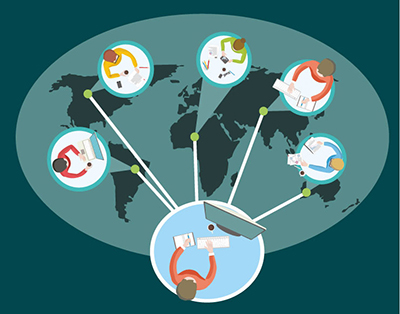Over the last 7 or so months, organizations have had to adapt to the new normal brought on by COVID-19. Social distancing guidelines forced recruiters and hiring managers to adopt a fully digital hiring process, and the same goes for managers and HR professionals tasked with onboarding remote new hires.

Despite the high unemployment rate, survey findings from The Manifest reveal that 6 in 10 companies have hired a new employee since the start of the COVID-19 pandemic, and as the economy ebbs and flows alongside the rising COVID cases, it is apparent that remote hiring and onboarding may be here to stay for another year or so!
The Manifest’s survey findings conclude that for successful remote hiring and onboarding, firms must welcome multiple new hires at once; establish healthy work habits; and follow a standardized, long-term onboarding plan.
“Businesses can use a strong onboarding plan to effectively welcome and train new hires despite the remote work environment,” says Seamus Roddy, Content Writer and Marketer for The Manifest. Based on The Manifest’s findings, Roddy shares four ways you can hire and onboard in a remote environment.
Onboarding en Masse
There are certain roles that are in high demand in the COVID era, and for these roles, recruiters are having to mass hire candidates at lightning speed; digital, remote onboarding will be the ticket to getting these workers on track quickly.
According to The Manifest, 46% of businesses that have hired during COVID-19 and onboarded 10 or more new employees indicate that companies should be prepared to welcome multiple new workers to their team at one time.
Due to social distancing guidelines, onboarding groups of workers seems inconceivable in the COVID era. But one of the beauties about remote technology is that it gives you the ability to onboard multiple new hires at once.
While virtual onboarding may be more efficient and less time-consuming, one of the downfalls is that it can feel impersonable. Instead, use video chat tools to have conversations with new hires that feel as if they are taking place face-to-face, suggests William Taylor, senior career adviser at VelvetJobs.
Standardize the Process
The Manifest’s research reveals that only 3% of companies expect more than one-third of their workforce to leave the company in the next year. “This suggests that standardized onboarding ensures teammates of different experience levels work together effectively and reduces turnover,” says Roddy.
“Standardized and documented employee onboarding is an effective strategy to ensure that all employees understand and respect the broader company,” Roddy adds. Additionally, if you want a truly standardized process, consider using onboarding software. This technology allows everyone from HR to accounting to management know what he or she needs to do to bring a new teammate up to speed.
Make It Long Term
Turnover was a major issue before the pandemic hit, but employers are still preparing for the worst. According to The Manifest data, 61% of companies expect new hires to stay at their company for 2 or more years, which means “onboarding should be a months-long process,” says Roddy. “If companies anticipate their employees will spend years on the payroll, having a months-long onboarding process makes sense.”
“Onboarding should be a gradual process because we spend money to acquire talent, and we want to retain it,” said J.P. Brousseau, CEO of Phone Loops. “Ensuring that new hires’ first year is productive, efficient, and positive helps us reduce turnover.”
Emphasize Healthy Work Habits
The data show that 37% of businesses say work/life imbalance is likely to cause employees to leave their company. Roddy suggests that businesses benefit when they use onboarding to make sure employees have healthy work habits. “Successful employees have healthy work habits, so companies should emphasize appropriate work-life balance when onboarding new employees,” he adds.
Roddy also says that most employees will make their judgments about the company during their onboarding experience, which means this is the most crucial time for a company to explain how it supports its workers’ health and safety.
During your onboarding process, make sure to emphasize flexible working arrangements, wellness benefits, sick leave policies, home-office stipends, and anything else that will ensure your new hires leave onboarding feeling welcomed and safe.
Depending on how you were onboarding during the pandemic, nothing may have changed, but for those who are new to remote hiring and onboarding, keep these best practices in mind during the “new normal.”
